An Exploratory Study on Resistance Spot Welding of Titanium Alloy Ti-6Al-4V
Abstract
1. Introduction
2. Experimental Procedure
3. Results and Discussions
3.1. Weld Nugget
3.2. Taguchi Method for Tensile-Shear Testing Results and Regression Analysis
3.3. Failure Mode
3.4. Microstructure
4. Conclusions
- The higher welding current increased the heat input significantly, which caused the wider melting zone in the faying layer of the contact area between the electrode and the sample. The weld nugget diameter and indentation depth tended to grow higher subsequently.
- The tensile testing maximum load was increased following the increase of heat input, but an expulsion was generated when the heat input highest level was achieved and the melted zone was overheated at a short welding time and ejected some material deposits instantly in the air.
- The heat input generation was affected significantly by the welding current followed by the welding time and the welding force. In the regression analysis, the response table for means shows the highest delta value with the medium level of welding current of 9 kA as the selected optimum level. This was supported by the highest stage with a welding time of 32 cycles and a welding force of 5 kN, which also created a dense fusion zone. Meanwhile, the lowest welding current created a colder weld. Otherwise, the highest welding current generated expulsion, although at this level a deeper penetration was achieved.
- The weld nugget strength reduction occurred in the highest stage and the lowest stage of heat input. These were indicated by the low maximum load results. In these levels, a brittle fracture also attacked the HAZ and the fusion zone. The selected optimum RSW parameters gave the highest tensile-shear testing result with no expulsion appearing in the weld nugget.
- When a higher heat input was applied, a larger martensitic microstructure with the α’-phase presence as the transformation from the β phase in β-transus temperature was formed with no pores appearing at all. This structure as a highly stressed structure was HCP, causing the fusion zone to have the highest hardness value among all areas.
Author Contributions
Funding
Institutional Review Board Statement
Informed Consent Statement
Data Availability Statement
Acknowledgments
Conflicts of Interest
References
- ASM. Welding Brazing and Soldering. In ASM Handbook; ASM International: Geauga, OH, USA, 1993; Volume 6. [Google Scholar]
- ASTM. Standard Specification for Titanium and Titanium Alloy Strip, Sheet, and Plate; ASTM B265-20; ASTM International: West Conshohocken, PA, USA, 2010. [Google Scholar]
- ASM International Handbook Committee. ASM Handbook Volume 2: Properties and Selection-Nonferrous Alloys and Special-Purpose Materials; ASM International: Geauga, OH, USA, 2001. [Google Scholar]
- Shafee, S.; Naik, B.B.; Sammaiah, K. Resistance Spot Weld Quality Characteristics Improvement by Taguchi Method. Mater. Today Proc. 2015, 2, 2595–2604. [Google Scholar] [CrossRef]
- Muhammad, N.; Manurung, Y.H.P.; Jaafar, R.; Abas, S.K.; Tham, G.; Haruman, E. Model Development for Quality Features of Resistance Spot Welding Using Multi-Objective Taguchi Method and Response Surface Methodology. J. Intell. Manuf. 2012, 24, 1175–1183. [Google Scholar] [CrossRef]
- Thakur, A.G.; Rao, T.E.; Mukhedkar, M.S.; Nandedkar, V.M. Application of Taguchi Method for Resistance Spot Welding of Galvanized Steel. J. Eng. Appl. Sci. 2010, 5, 22–26. [Google Scholar]
- Eşme, U. Application of Taguchi Method for the Optimization of Resistance Spot Welding Process. Arab. J. Sci. Eng. 2009, 34, 519–528. [Google Scholar]
- Lee, H.T.; Chang, Y.C. Effect of Double Pulse Resistance Spot Welding Process on 15B22 Hot Stamped Boron Steel. Metals 2020, 10, 1279. [Google Scholar] [CrossRef]
- Kobayashi, T.; Mihara, Y. Numerical simulation of nugget formation in spot welding: Mechanical Design & Analysis Corporation. In Proceedings of the SIMULIA Community Conference, Providence, RI, USA, 22 May 2014. [Google Scholar]
- Williams, N.T.; Parker, J.D. Review of Resistance Spot Welding of Steel Sheets: Part 2—Factors Influencing Electrode Life. Int. Mater. Rev. 2004, 49, 77–108. [Google Scholar] [CrossRef]
- Wohner, M.; Mitzschke, N.; Jüttner, S. Resistance Spot Welding with Variable Electrode Force—Development and Benefit of a Force Profile to Extend the Weldability of 22MnB5+AS150. Weld. World 2021, 65, 105–117. [Google Scholar] [CrossRef]
- Bick, T.; Heuler, V.; Treutler, K.; Wesling, V. Characterization of Influences of Steel-Aluminum Dissimilar Joints with Intermediate Zinc Layer. Metals 2020, 10, 442. [Google Scholar] [CrossRef]
- Wesling, V.; Rekersdrees, T.; Keitel, S.; Winkler, R.; Schreiber, S. Investigations into the resistance spot welding of newly developed sheets made of higher-strength and super-high-strength steels. Weld. Cut. 2004, 56, 168–173. [Google Scholar]
- Shirmohammadi, D.; Mojtaba, M.; Majid, P. Resistance Spot Welding of Martensitic Stainless Steel: Effect of Initial Base Metal Microstructure on Weld Microstructure and Mechanical Performance. Mater. Sci. Eng. A 2017, 703, 154–161. [Google Scholar] [CrossRef]
- Alizadeh-Sh, M.; Marashi, S.P.H.; Pouranvari, M. Resistance Spot Welding of AISI 430 Ferritic Stainless Steel: Phase Transformations and Mechanical Properties. Mater. Des. 2014, 56, 258–263. [Google Scholar] [CrossRef]
- Chao, Y.J. Failure Mode of Spot Welds: Interfacial versus Pullout. Sci. Technol. Weld. Join. 2003, 8, 133–137. [Google Scholar] [CrossRef]
- Pouranvari, M.; Marashi, S.P.H. Failure Mode Transition in AHSS Resistance Spot Welds. Part I. Controlling Factors. Mater. Sci. Eng. A 2011, 528, 8337–8343. [Google Scholar] [CrossRef]
- Pouranvari, M.; Marashi, S.P.H. Critical Review of Automotive Steels Spot Welding: Process, Structure, and Properties. Sci. Technol. Weld. Join. 2013, 18, 361–403. [Google Scholar] [CrossRef]
- Pouranvari, M.; Marashi, S.P.H.; Safanama, D.S. Failure Mode Transition in AHSS Resistance Spot Welds. Part II: Experimental Investigation and Model Validation. Mater. Sci. Eng. A 2011, 528, 8344–8352. [Google Scholar] [CrossRef]
- Marashi, P.; Pouranvari, M.; Amirabdollahian, S.; Abedi, A.; Goodarzi, M. Microstructure and Failure Behavior of Dissimilar Resistance Spot Welds between Low Carbon Galvanized and Austenitic Stainless Steels. Mater. Sci. Eng. A 2008, 480, 175–180. [Google Scholar] [CrossRef]
- Mansor, M.S.M.; Farazila, Y.; Tadashi, A.; Yukio, M. Microstructure and Mechanical Properties of Micro-Resistance Spot Welding between Stainless Steel 316L and Ti-6Al-4V. Int. J. Adv. Manuf. Technol. 2018, 96, 2567–2581. [Google Scholar] [CrossRef]
- Yu, G.; Chen, X.; Zhang, B.; Pan, K.; Yang, L. Tensile-shear mechanical behaviors of friction stir spot weld and adhesive hybrid joint: Experimental and numerical study. Metals 2020, 10, 1028. [Google Scholar] [CrossRef]
- Zhang, X.; Jiangshuai, Z.; Fei, C.; Zhaojun, Y.; Jialong, H. Characteristics of Resistance Spot Welded Ti6Al4V Titanium Alloy Sheets. Metals 2017, 7, 424. [Google Scholar] [CrossRef]
- Kahraman, N. The Influence of Welding Parameters on the Joint Strength of Resistance Spot-Welded Titanium Sheets. Mater. Des. 2007, 28, 420–427. [Google Scholar] [CrossRef]
- ASTM. Standard Test Method for Apparent Shear Strength of Single-Lap-Joint Adhesively Bonded Metal Specimens by Tension Loading (Metal-to-Metal); ASTM D1002-99; ASTM International: West Conshohocken, PA, USA, 1999. [Google Scholar]
- Koenigsberger, F. Design for Welding in Mechanical Engineering; Longmans: London, UK; Butterworth-Heinemann: Oxford, UK, 1948; pp. 81–91. [Google Scholar]
- Stufken, J.; Glen, S.P. Taguchi Methods: A Hands-On Approach. Technometrics 1994, 36, 121. [Google Scholar] [CrossRef]
- ASTM. Standard Test Methods for Tension Testing of Metallic Materials 1; ASTM E8/E8M-16a; ASTM International: West Conshohocken, PA, USA, 2020. [Google Scholar]
- Minitab. Minitab Software; 19.1.1, 64-bit; Minitab, Inc.: State College, PA, USA, 2019. [Google Scholar]
- ASTM. Standard Practice for Microetching Metals and Alloys; ASTM E407-07; ASTM International: West Conshohocken, PA, USA, 2015. [Google Scholar]
- ISO. ISO 16700:2016 Microbeam Analysis—Scanning Electron Microscopy—Guidelines for Calibrating Image Magnification; ISO/TC 202/SC 4; ISO: Geneva, Switzerland, 2016. [Google Scholar]
- ISO. ISO 21466:2019 Microbeam Analysis—Scanning Electron Microscopy—Method for Evaluating Critical Dimensions by CD-SEM; ISO/TC 202/SC 4; ISO: Geneva, Switzerland, 2019. [Google Scholar]
- ISO. ISO/TS 24597:2011 Microbeam Analysis—Scanning Electron Microscopy—Methods of Evaluating Image Sharpness; ISO/TC 202/SC 4; ISO: Geneva, Switzerland, 2011. [Google Scholar]
- ASTM. Standard Test Methods for Vickers Hardness and Knoop Hardness of Metallic Materials; ASTM E92; ASTM International: West Conshohocken, PA, USA, 2017. [Google Scholar]
- Hwang, I.S.; Kang, M.J.; Kim, D.C. Expulsion reduction in resistance spot welding by controlling of welding current waveform. Procedia Eng. 2011, 10, 2775–2781. [Google Scholar] [CrossRef]
- Ghazanfari, H.; Naderi, M. Expulsion Characterization in Resistance Spot Welding by Means of a Hardness Mapping Technique. Int. J. Miner. Met. Mater. 2014, 21, 894–897. [Google Scholar] [CrossRef]
- Motyka, M.; Kubiak, K.; Sieniawski, J.; Ziaja, W. Phase Transformations, and Characterization of α + β Titanium Alloys. Comp. Mat. Proc. 2014, 7–36. [Google Scholar] [CrossRef]
- Irwin, J. Modeling Microstructure of AM Processes Using the FE Method. J. Manuf. Sci. Eng. 2017, 117–135. [Google Scholar] [CrossRef]
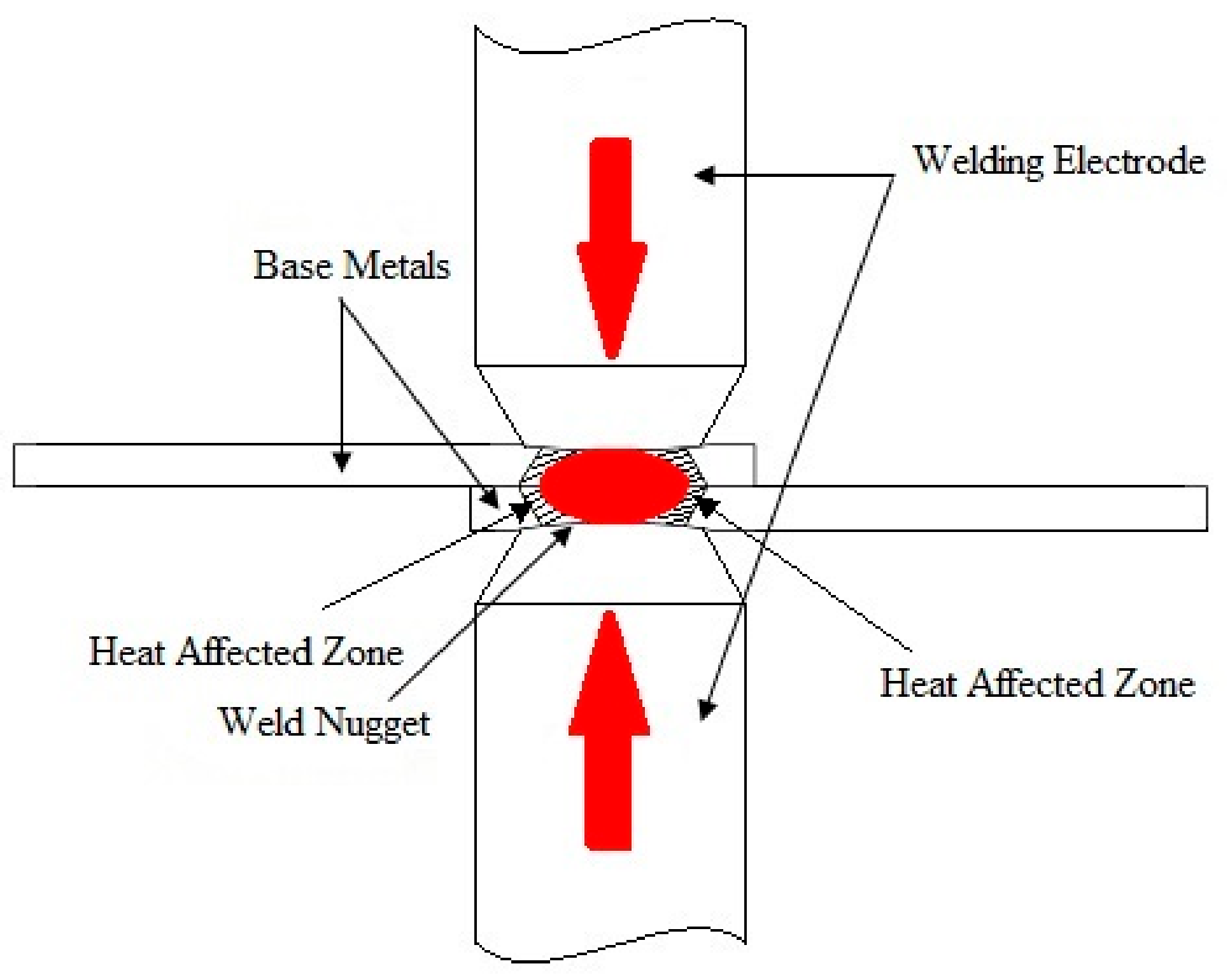

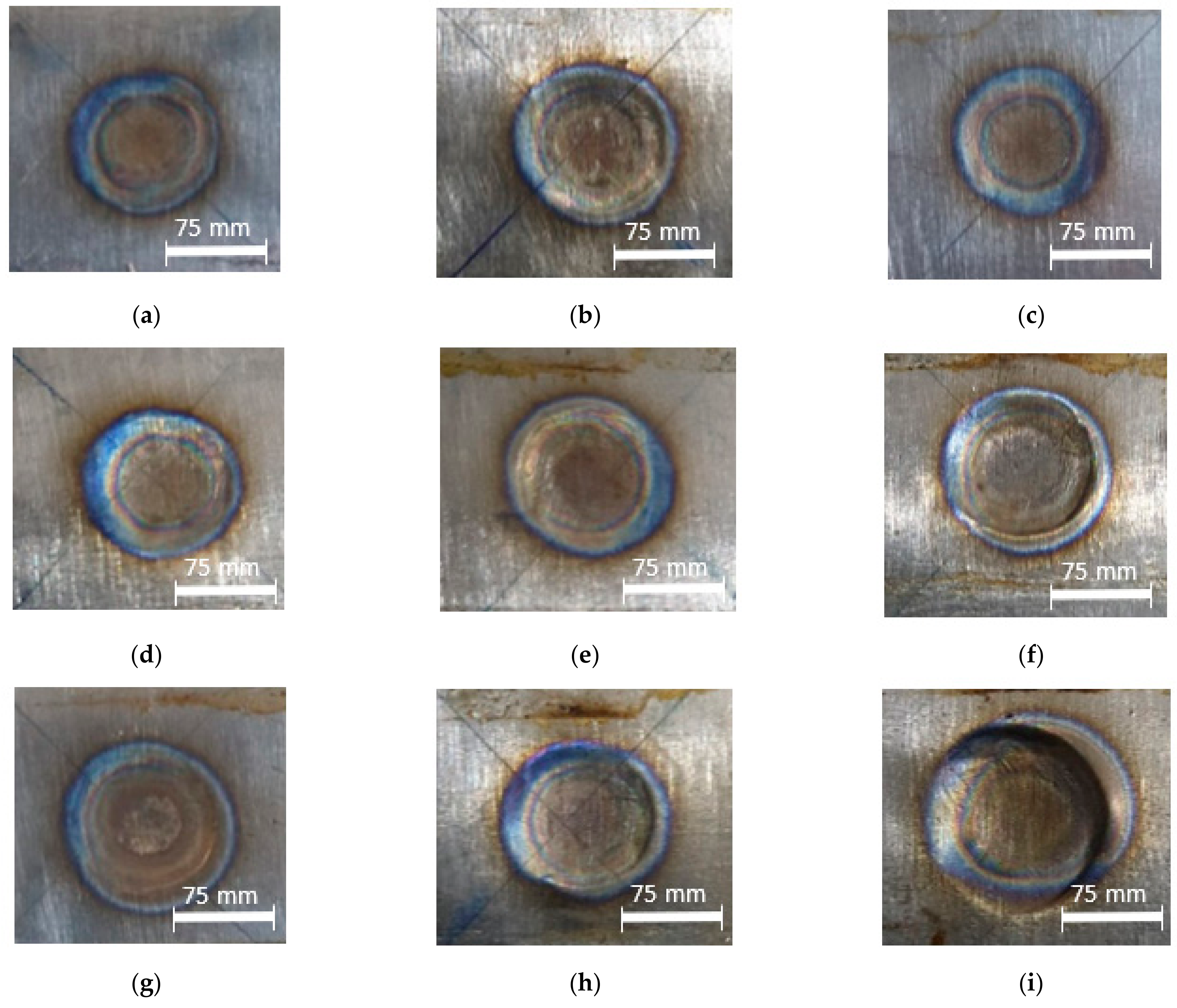

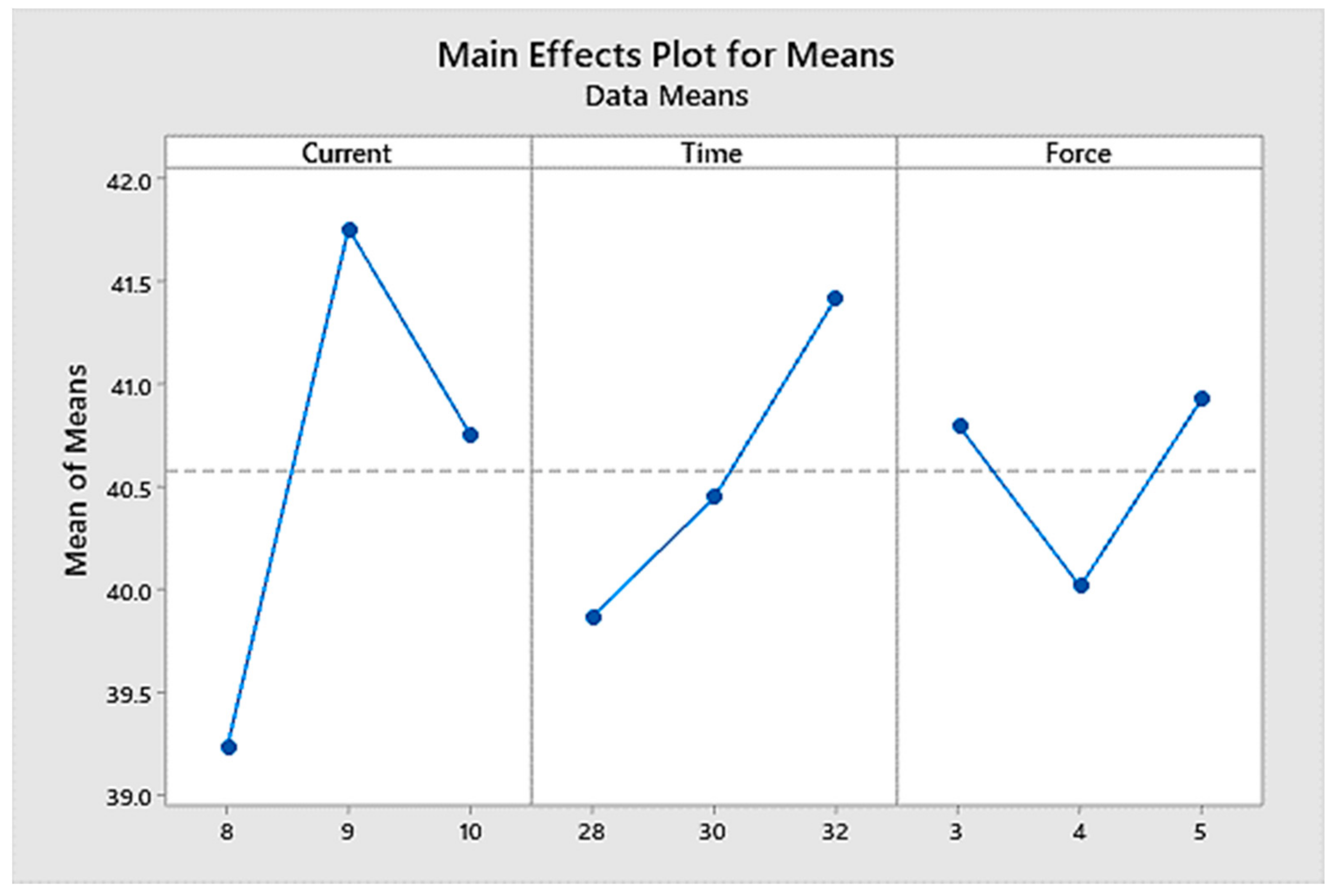

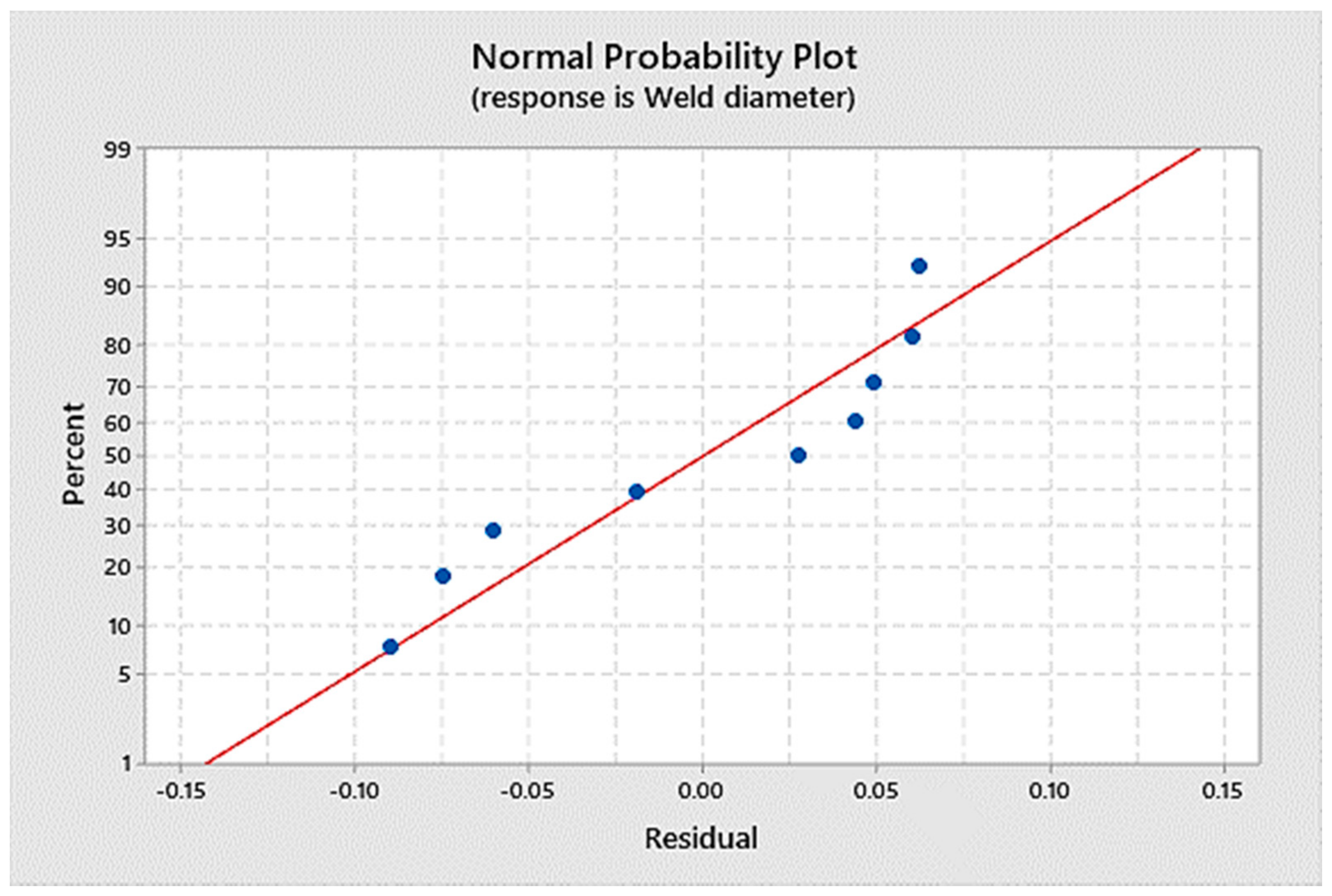
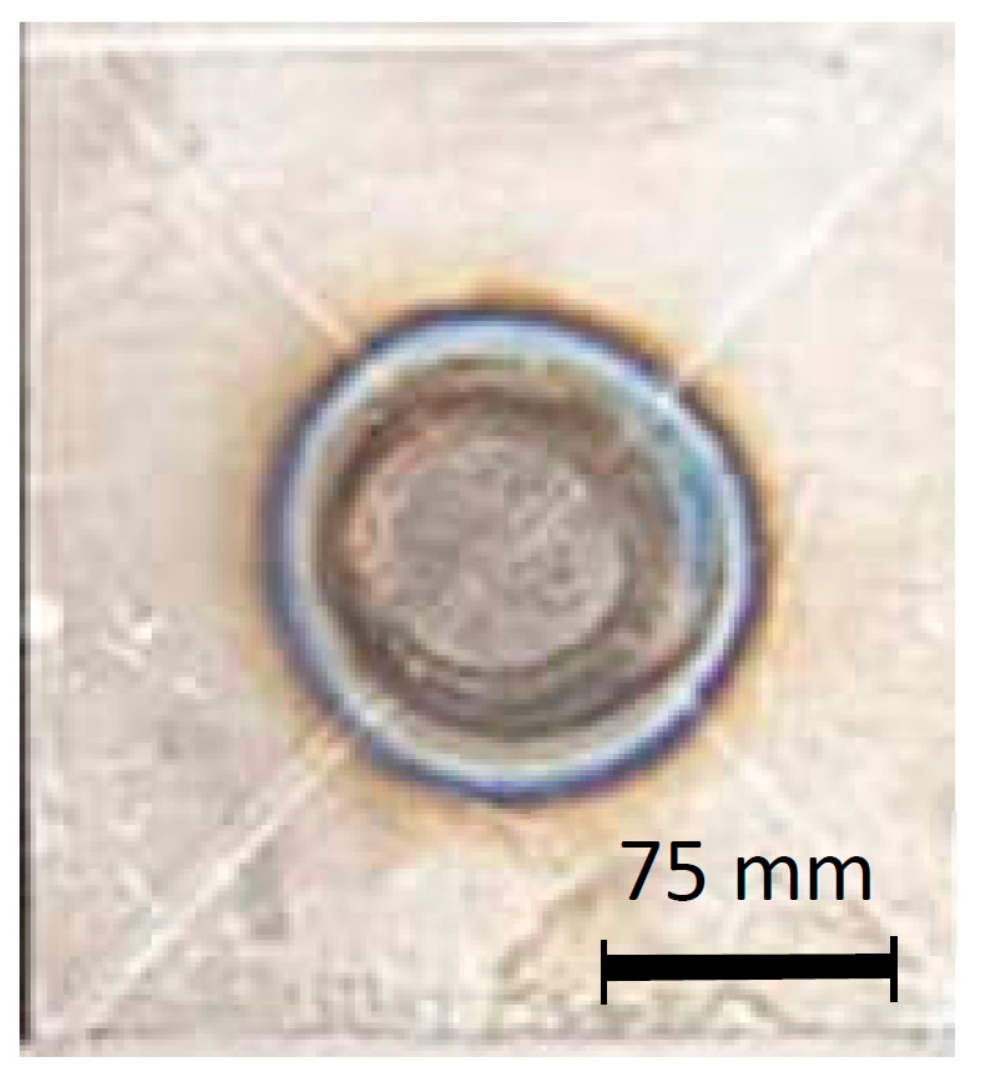
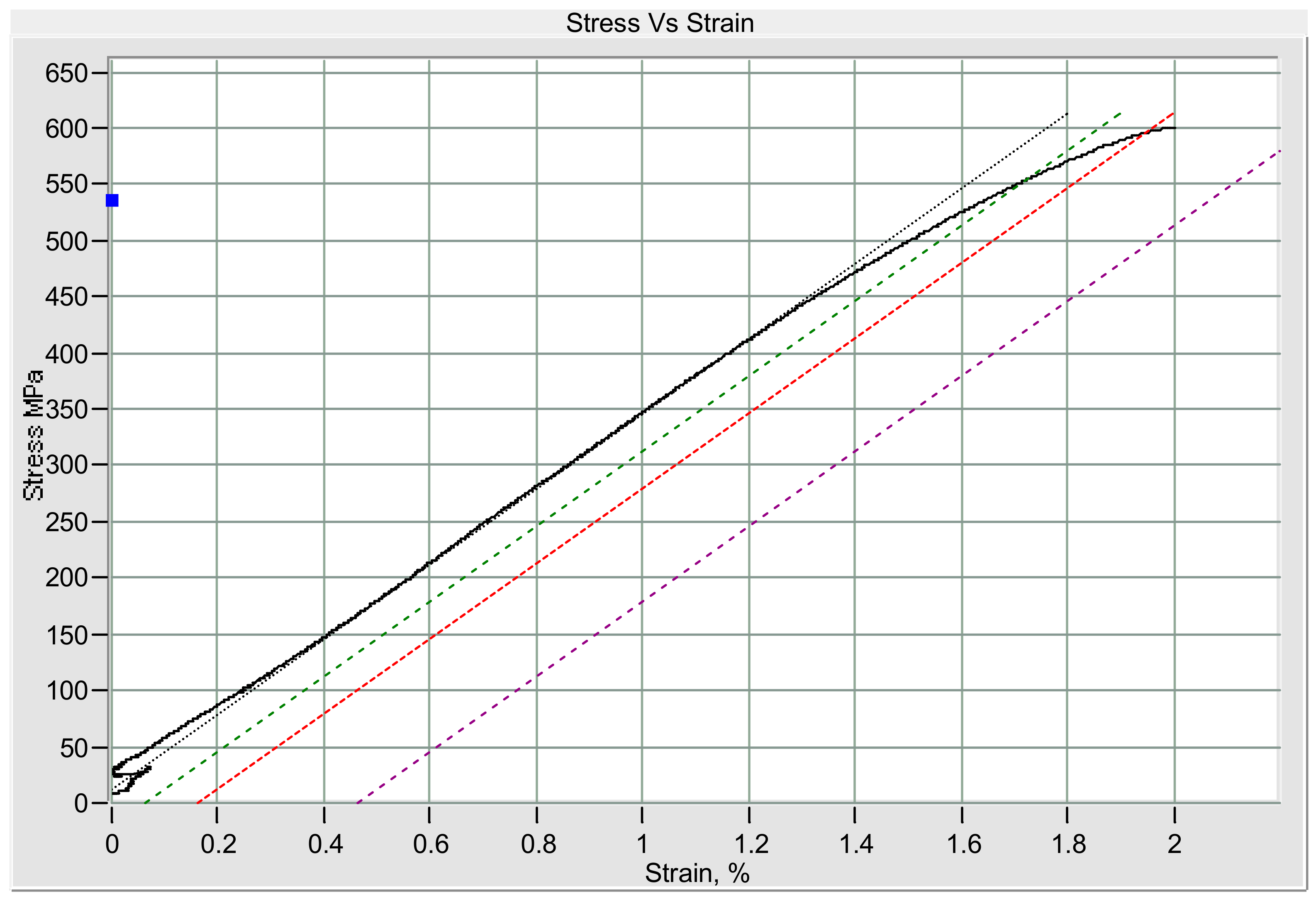
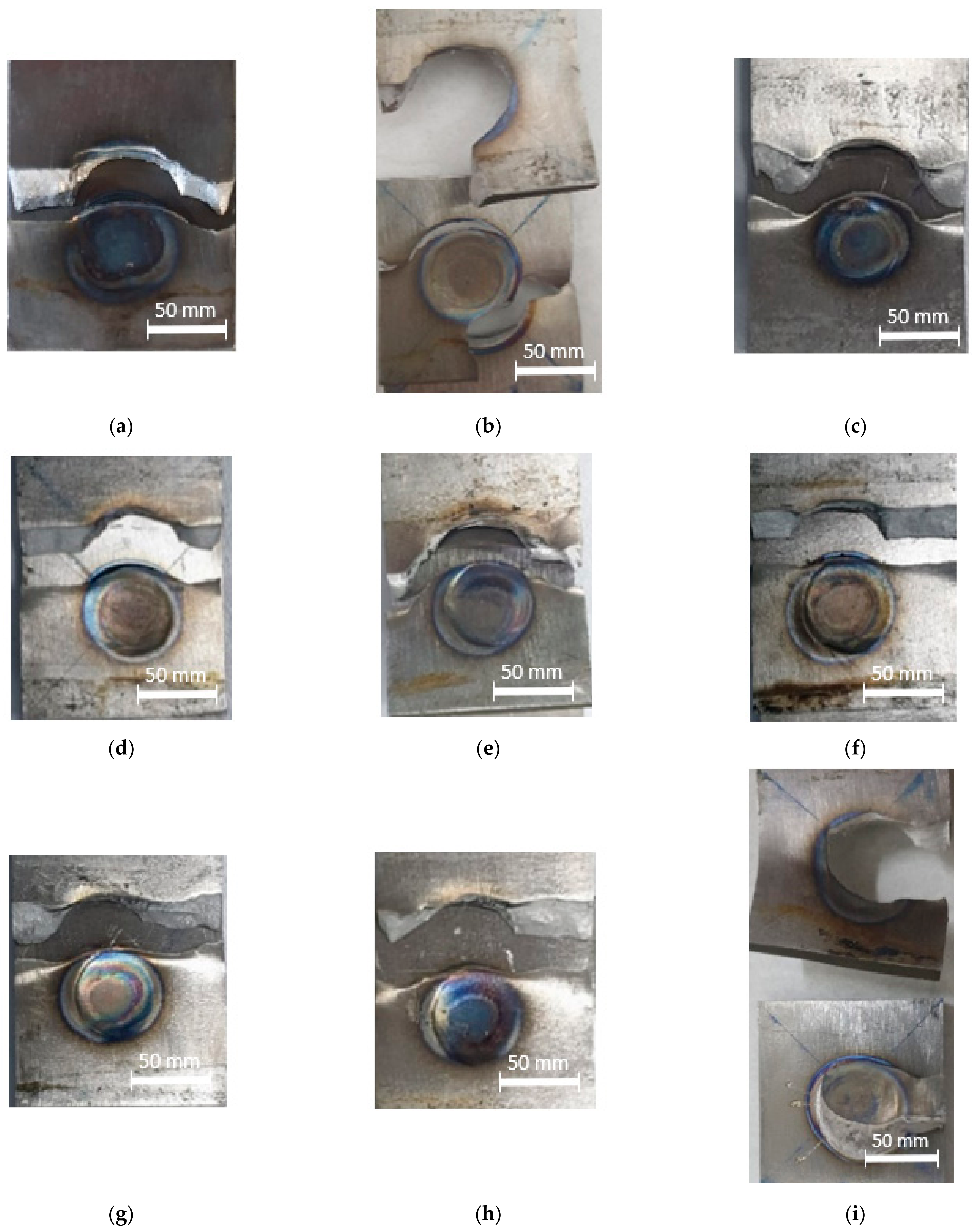

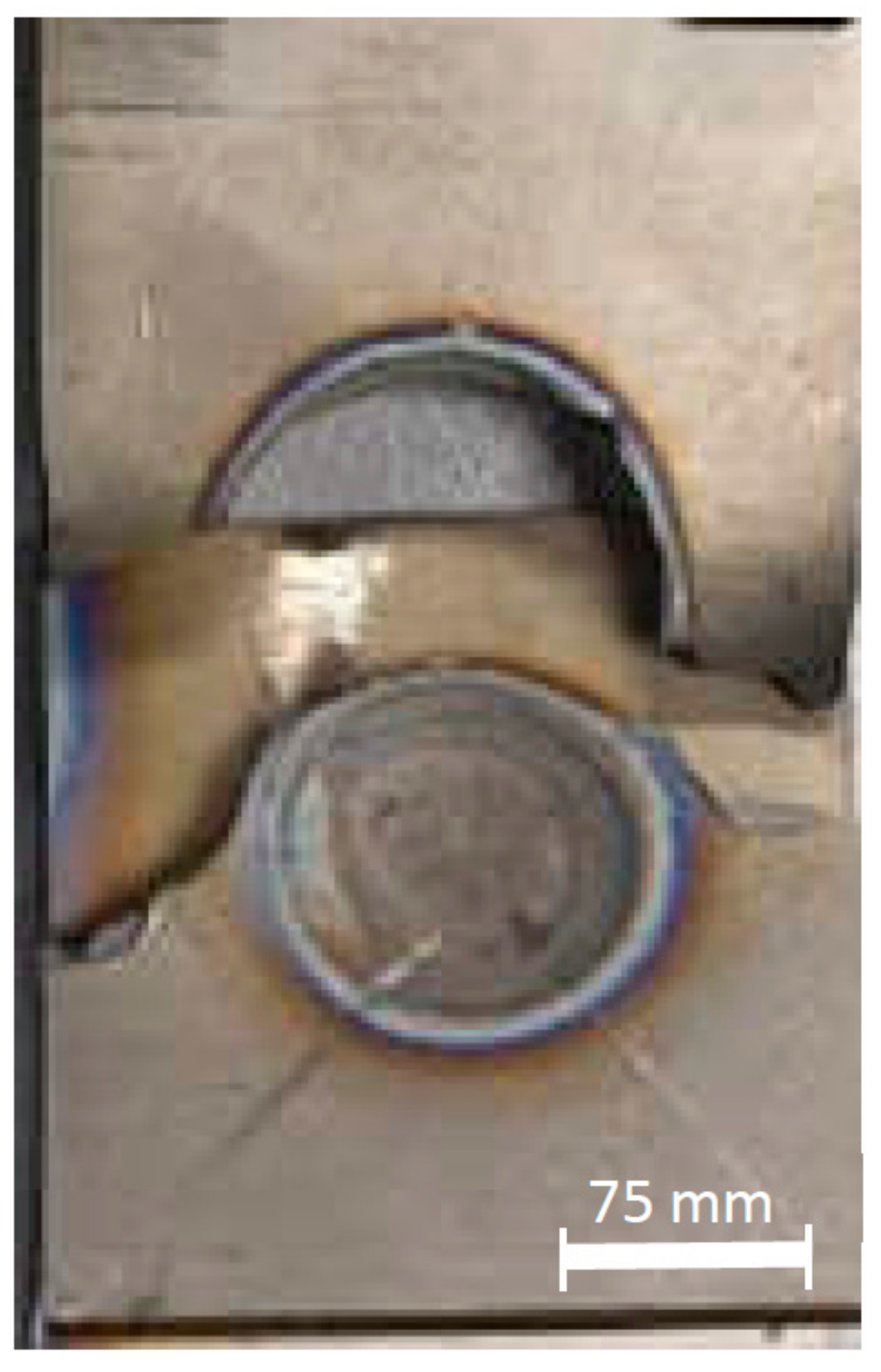
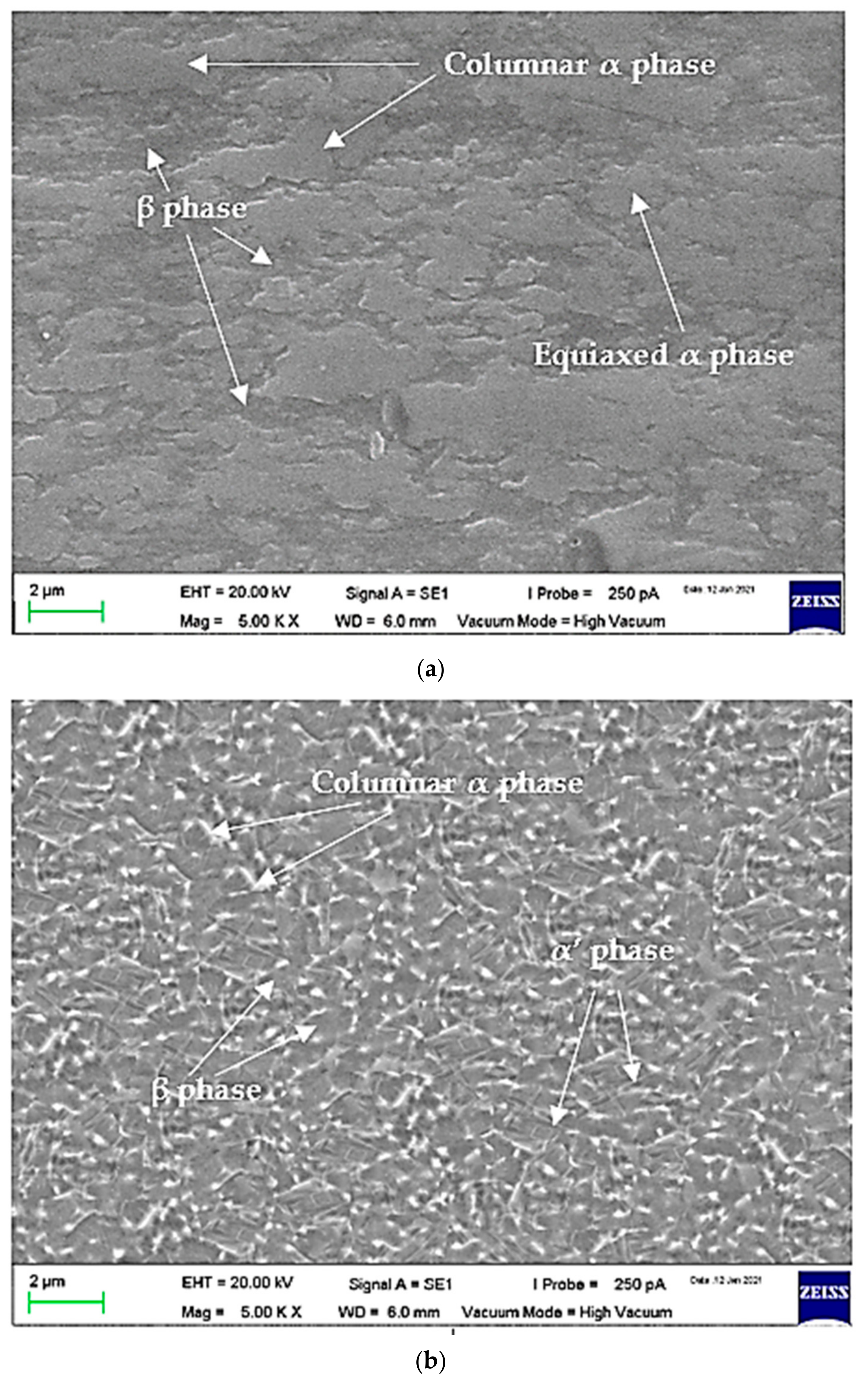
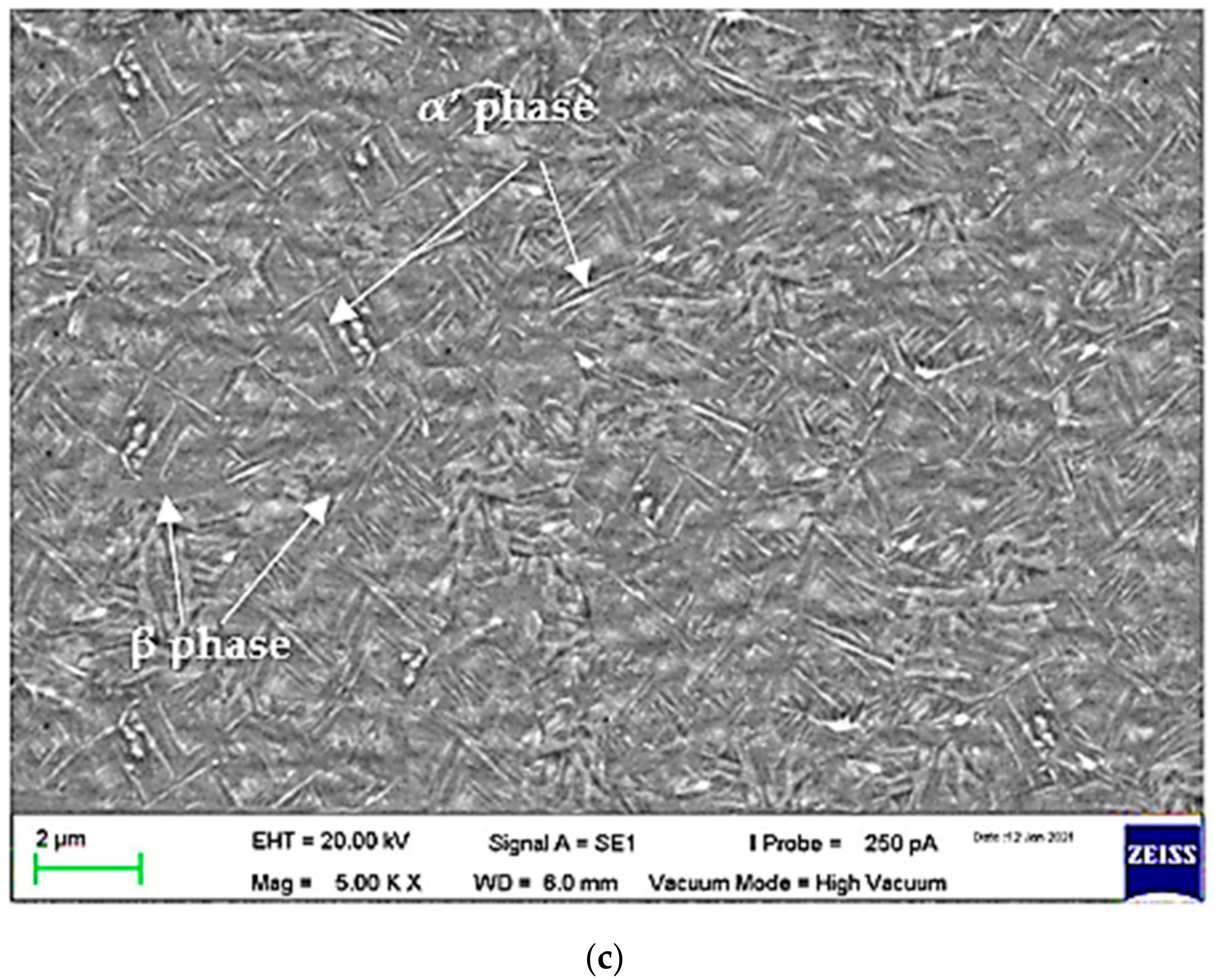

| Element | Composition (%) |
|---|---|
| Nitrogen (max) | 0.05 |
| Carbon (max) | 0.08 |
| Hydrogen (max) | 0.015 |
| Iron (max) | 0.40 |
| Oxygen (max) | 0.20 |
| Aluminum | 5.5–6.75 |
| Vanadium | 3.5–4.5 |
| Titanium | Balance |
| Experiment | Welding Current (kA) | Welding Time (Cycles) | Welding Force (kN) |
|---|---|---|---|
| 1 | 8 | 28 | 3 |
| 2 | 8 | 30 | 4 |
| 3 | 8 | 32 | 5 |
| 4 | 9 | 28 | 4 |
| 5 | 9 | 30 | 5 |
| 6 | 9 | 32 | 3 |
| 7 | 10 | 28 | 5 |
| 8 | 10 | 30 | 3 |
| 9 | 10 | 32 | 4 |
| Experiment | Welding Current (kA) | Welding Time (Cycles) | Welding Force (kN) | Max Load (kN) |
|---|---|---|---|---|
| 1 | 8 | 28 | 3 | 38.061 |
| 2 | 8 | 30 | 4 | 39.51 |
| 3 | 8 | 32 | 5 | 40.111 |
| 4 | 9 | 28 | 4 | 40.167 |
| 5 | 9 | 30 | 5 | 41.295 |
| 6 | 9 | 32 | 3 | 43.795 |
| 7 | 10 | 28 | 5 | 41.366 |
| 8 | 10 | 30 | 3 | 40.532 |
| 9 | 10 | 32 | 4 | 40.361 |
| Experiment | Welding Current (kA) | Welding Time (Cycles) | Welding Force (kN) |
|---|---|---|---|
| 1 | 39.23 | 39.86 | 40.80 |
| 2 | 41.75 | 40.45 | 40.01 |
| 3 | 40.75 | 41.42 | 40.92 |
| Delta | 2.53 | 1.56 | 0.91 |
| Rank | 1 | 2 | 3 |
| Source | DF | Adjusted SS | Adjusted MS | F-Value | p-Value |
|---|---|---|---|---|---|
| Regression | 3 | 7.156 | 2.385 | 0.97 | 0.474 |
| Current | 1 | 3.491 | 3.491 | 1.43 | 0.286 |
| Time | 1 | 3.639 | 3.639 | 1.49 | 0.277 |
| Force | 1 | 0.025 | 0.025 | 0.01 | 0.924 |
| Error | 5 | 12.240 | 2.448 | - | - |
| Total | 8 | 19.396 | - | - | - |
| Peak Stress (MPa) | Peak Load (kN) | 0.2% Offset Yield Stress (MPa) | Yield Strain (%) | Yield Load (kN) | 0.02% Offset Yield Stress (MPa) | Modulus (GPa) | 0.1% Offset Yield Stress (MPa) |
|---|---|---|---|---|---|---|---|
| 599.724 | 44.979 | 595.68 | 1.947 | 44.676 | 461.483 | 33.409 | 553.845 |
Publisher’s Note: MDPI stays neutral with regard to jurisdictional claims in published maps and institutional affiliations. |
© 2021 by the authors. Licensee MDPI, Basel, Switzerland. This article is an open access article distributed under the terms and conditions of the Creative Commons Attribution (CC BY) license (https://creativecommons.org/licenses/by/4.0/).
Share and Cite
Fatmahardi, I.; Mustapha, M.; Ahmad, A.; Derman, M.N.; Lenggo Ginta, T.; Taufiqurrahman, I. An Exploratory Study on Resistance Spot Welding of Titanium Alloy Ti-6Al-4V. Materials 2021, 14, 2336. https://doi.org/10.3390/ma14092336
Fatmahardi I, Mustapha M, Ahmad A, Derman MN, Lenggo Ginta T, Taufiqurrahman I. An Exploratory Study on Resistance Spot Welding of Titanium Alloy Ti-6Al-4V. Materials. 2021; 14(9):2336. https://doi.org/10.3390/ma14092336
Chicago/Turabian StyleFatmahardi, Ichwan, Mazli Mustapha, Azlan Ahmad, Mohd Nazree Derman, Turnad Lenggo Ginta, and Iqbal Taufiqurrahman. 2021. "An Exploratory Study on Resistance Spot Welding of Titanium Alloy Ti-6Al-4V" Materials 14, no. 9: 2336. https://doi.org/10.3390/ma14092336
APA StyleFatmahardi, I., Mustapha, M., Ahmad, A., Derman, M. N., Lenggo Ginta, T., & Taufiqurrahman, I. (2021). An Exploratory Study on Resistance Spot Welding of Titanium Alloy Ti-6Al-4V. Materials, 14(9), 2336. https://doi.org/10.3390/ma14092336







